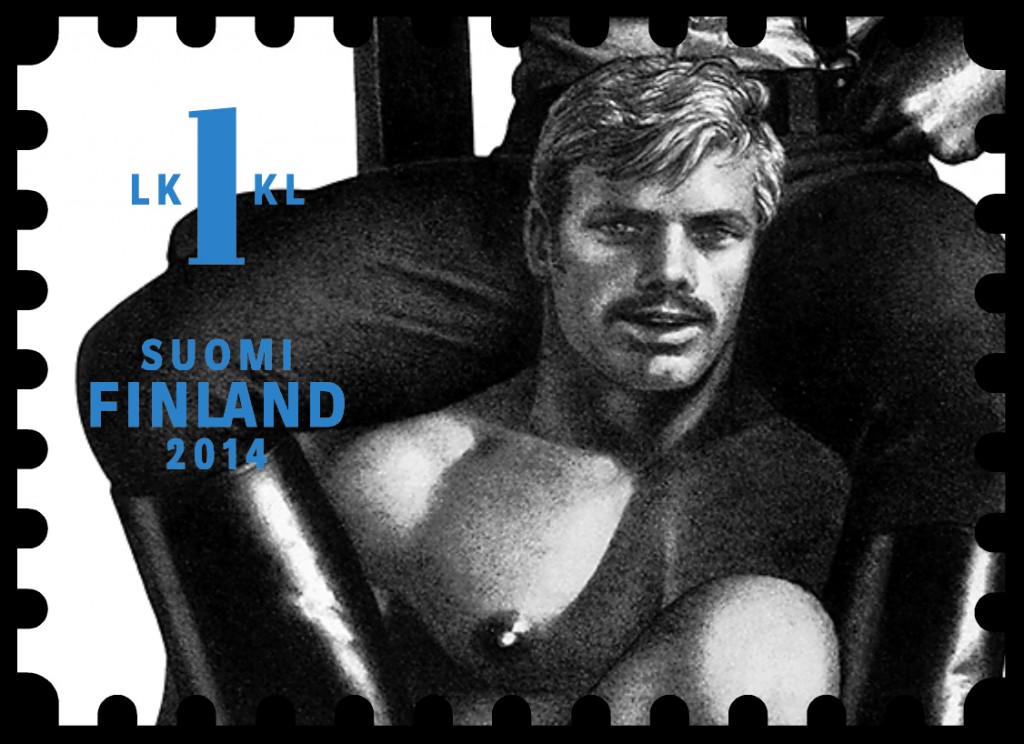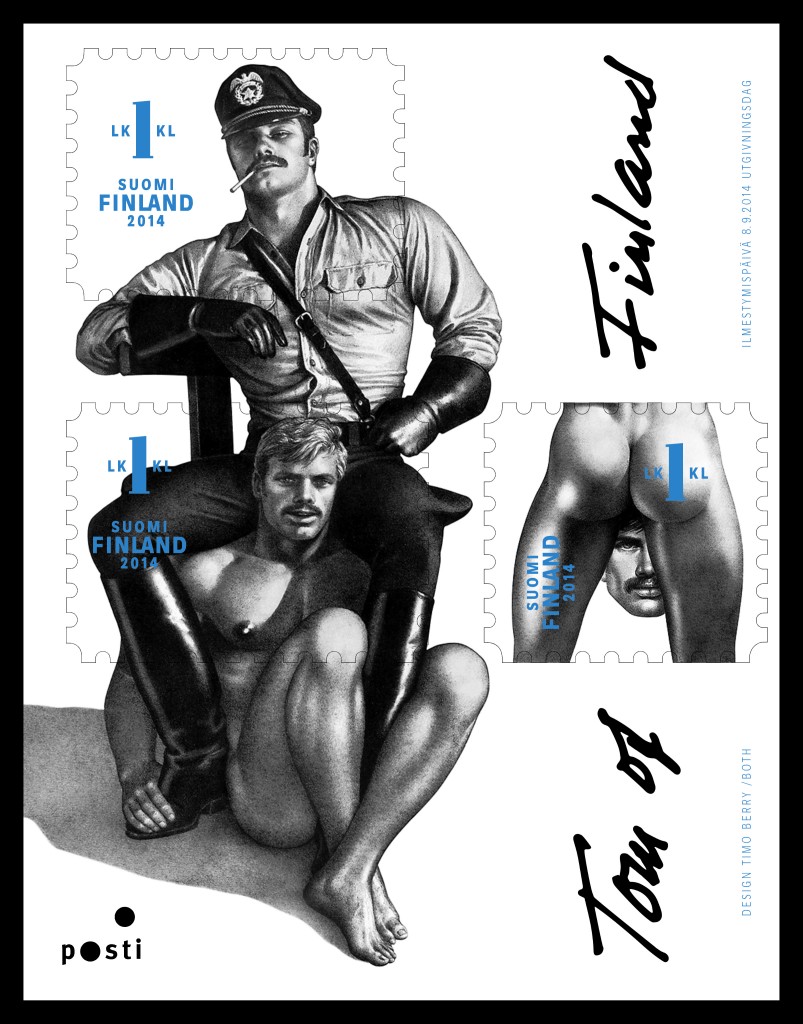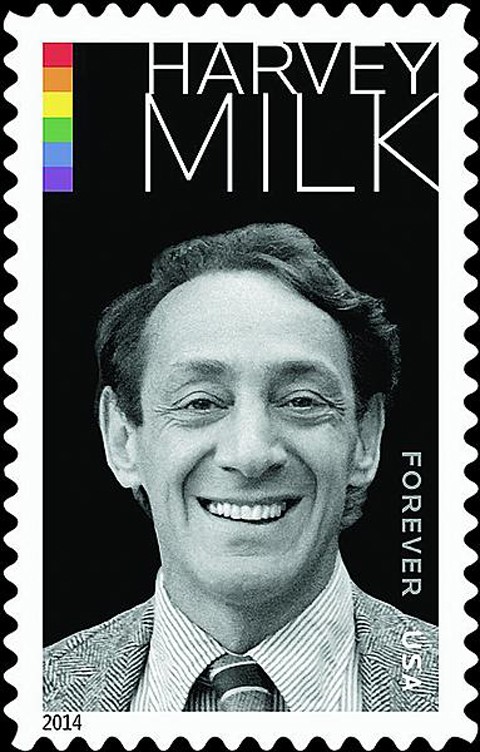 On April 13, 2014, Itella Posti Oy, the Finnish postal service, announced the release in September of what are possibly the most openly erotic postage stamps to appear anywhere in mainstream circulation. The series of three stamps commemorate the work of Touko Laaksonen (1920-1991), better known as Tom of Finland (link NSFW). The Finnish stamps are remarkable for their unambiguous and deliberate depiction of homoerotic images, nudity, and dom/sub sexuality that Itella lauds as “confident and proud homoeroticism.” They are also remarkable for their memorialization of a queer man through explicit depictions of the erotic art for which he became an icon to other queer men around the world from the 1950s onward. But looking at the Tom of Finland stamps, and recognizing postage stamps as an incredibly accessible and widely distributed site for history and commemoration, it is worth considering how other queer men and women have recently been featured. How do postage stamps contribute to a public history of queer lives and sexualities?
On April 13, 2014, Itella Posti Oy, the Finnish postal service, announced the release in September of what are possibly the most openly erotic postage stamps to appear anywhere in mainstream circulation. The series of three stamps commemorate the work of Touko Laaksonen (1920-1991), better known as Tom of Finland (link NSFW). The Finnish stamps are remarkable for their unambiguous and deliberate depiction of homoerotic images, nudity, and dom/sub sexuality that Itella lauds as “confident and proud homoeroticism.” They are also remarkable for their memorialization of a queer man through explicit depictions of the erotic art for which he became an icon to other queer men around the world from the 1950s onward. But looking at the Tom of Finland stamps, and recognizing postage stamps as an incredibly accessible and widely distributed site for history and commemoration, it is worth considering how other queer men and women have recently been featured. How do postage stamps contribute to a public history of queer lives and sexualities?

Deliberate queer content is relatively new to the philatelic world even if gay men and lesbians have long appeared on stamps in a their professional capacities as, among others, artists, authors, politicians and scientists. In 2011 the UK Royal Mail even issued a stamp recognizing iconic Harry Potter wizard Dumbledore, whom author J.K. Rowling outed in 2007. Austria, however, was reportedly the first nation to issue a consciously gay themed postage stamp in 2010, textually commemorating the 15 year anniversary of Vienna’s Regenbogen (Rainbow) Parade.
In October 2013, the US Postal Service announced a new stamp featuring gay activist and politician Harvey Milk, who became California’s first openly gay elected official in 1978, the same year he was assassinated. In March 2014, Linns Stamp News released the stamp design – an inoffensive black and white portrait accompanied by a stack of squares in the pride flag colours – announcing that it would appear on May 22, Harvey Milk Day.
The US Postal Service’s choice to depict Harvey Milk is a safe one. Milk is a conveniently martyred hero of the movement who can do little to embarrass officials. Further, he has already entered the mainstream, having been legitimized by a 2008 Oscar-winning eponymous film. Milk’s classic black and white photo on the stamp also adheres to conventional iconography of past notables. It is a pleasant if unremarkable image of a man, kindly faced and reassuringly smiling, jacket-and-tie clad, non-sexual and unthreatening. Of course, that’s also part of the point.

There is a politics at play here, a careful politics of sameness that has long been utilized by equality movements. This isn’t to dismiss the importance of the Milk stamp, nor to deny the powerful message it sends, but to contextualize it. In a nation perpetually divided by culture wars that cohere in particular around depictions of sexuality and divisive discussions of its non-heterosexual citizens, the decision by an agency of the US federal government to depict any positive or progressive gay imagery is a fraught one. It is therefore also a useful contrast to the Finnish example.
In Finland, homosexual acts have only been decriminalized since 1971, and civil partnerships available to same-sex couples since 2002. Unlike some US states, full marriage equality has not yet been achieved in Finland, but it is currently a major issue. In March 2013, an equal marriage bill was narrowly defeated in committee and therefore did not go forward to the Finnish Parliament. And in September, following a national campaign that collected 162,000 signatures, YLE, the Finnish national broadcaster, reported that the initiative would now go to Parliament. Debate began in February 2014, and gender-neutral marriage has since been declared “imminent” by YLE. Around the same time that this was happening, in September 2013, global film media announced that leading, young Finnish director Dome Karukoski would make his English-language debut with the first authorized biopic about Tom of Finland.
At a time when global postage sales are in decline in the face of increased e-communications, the decision to issue Tom of Finland postage stamps seems at least in part motivated by this increased attention to gay and lesbian issues in Finland and also increased interest in the life of Laaksonen himself. To its credit but also highlighting its own iconoclasm, Itella in no way obscures Tom of Finland’s historic queer significance:
His emphatically masculine homoerotic drawings have attained iconic status in their genre and had an influence on, for instance, pop culture and fashion. In his works, Tom of Finland utilized the self-irony and humor typical of subcultures.
But the Finnish postal service’s Tom of Finland stamps are most remarkable for their own visual content. The stamps rely on Laaksonen’s explicitly homoerotic art that here clearly depicts dom/sub relations. Two stamps are taken from a single image of one man sitting naked at the booted feet of another fully-dressed man. The naked man is held in place by the legs of his leather-clad dom cop who is replete with cigar, cap, martial uniform, and steely gaze. The third stamp in the series suggests an active sexual scenario no less than the others. It shows a man’s face framed by the nude upper legs and buttocks of his erotic partner, the position of his head suggesting proximity to the other man’s out-of-view but potentially erect cock. Designers have playfully centred the 1st Class indicator on his right buttock. No need to lick, the self-adhesive stamps are ready for use. Their public depiction of homoerotic imagery will literally enter through the front door of any home.
Besides appearing strategically at a moment of particular interest in homosexuality in Finland, the stamps’ launch is also precisely timed to coincide with the opening of a new Postal Museum in Finland’s historically industrial city Tampere. The stamps will come into circulation just two days after the opening of the exhibition Sealed with a Secret – Correspondence of Tom of Finland on 6 September, which traces 70 years of the artist’s letters, art and photos.
Besides contrasting the iconoclasm of the Tom of Finland stamps to the conservatism of the Harvey Milk stamp, it is also useful to contrast the erotically charged Tom of Finland stamps with those commemorating the life another queer Finn this year. On the 100 year anniversary of her birth, Finnish lesbian icon and Moomin author Tove Jansson (1914-2001) was memorialized in January 2014 by her own pair of stamps. Itella described Jansson simply as a “multitalented author and illustrator”, “a versatile artist” who dearly loved the Finnish Archipelago. The only oblique signal to her queerness is the statement that “Throughout her life, open-mindedness and the pursuit of freedom were among Tove Jansson’s strengths.”

Both sets of stamps emphasize their subject’s professional lives. Laaksonen’s erotic art is the feature of his stamps, indeed the man himself is entirely absent from them except in the form of his pseudonym and distinctive style. Jansson’s stamps highlight her professional role as a noted author and association with Finland’s natural environment, entirely neglecting her place as a lesbian icon. They feature her only in relation to her cherished island idyll and the Moomins she created there. Notably, however, Jansson’s life partner and professional collaborator Tuulikki Pietilä, with whom she shared both the isolated cottage pictured in one stamp and the fictional Moominvalley characters like Sniff, who appears in the other stamp, is nowhere mentioned in Itella‘s promotional materials.
Comparing these two sets of stamps, which in the same year both commemorate the lives and works of prominent queer Finns, it is impossible not to see a range of gender issues at play. Taken together, they suggest interesting contrasts between public representations of queer male and female sexualities. Read beside each other, they appear to reinforce a sexualized understanding of queer men, but remove any trace sexuality from the life of Jansson.
Of course this binary characterization isn’t quite so simple. Laaksonen’s success, after all, was based on explicit depictions of homoerotic even pornographic situations. And Jansson is known predominantly for her children’s books, even if those same books incorporated elements of her personal life, including fictionalized accounts of her relationship with Pietilä. And finally, the choice of Harvey Milk as the first queer-themed subject of a US postage stamp illuminates contexts in which displaying a sexualized queer male body is simply not politic. Each of these stamps, publicly available and widely advertised, contributes to a public history of queer lives and sexualities. And across all three images, gender, politics and commerce cannot be divorced from public commemorations of historical queer icons.
 Justin Bengry is an Honorary Research Fellow at Birkbeck, University of London and a SSHRC Postdoctoral Fellow in History at McGill University, Canada. Justin’s research focuses on the intersection of homosexuality and consumer capitalism in twentieth-century Britain, and he is currently revising a book manuscript titled The Pink Pound: Queer Profits in Twentieth-Century Britain. He tweets from @justinbengry
Justin Bengry is an Honorary Research Fellow at Birkbeck, University of London and a SSHRC Postdoctoral Fellow in History at McGill University, Canada. Justin’s research focuses on the intersection of homosexuality and consumer capitalism in twentieth-century Britain, and he is currently revising a book manuscript titled The Pink Pound: Queer Profits in Twentieth-Century Britain. He tweets from @justinbengry

NOTCHES: (re)marks on the history of sexuality is licensed under a Creative Commons Attribution-NonCommercial-NoDerivatives 4.0 International License.
Based on a work at www.notchesblog.com.
For permission to publish any NOTCHES post in whole or in part please contact the editors at NotchesBlog@gmail.com





Great article. I think that all of your conclusions are spot-on, and I really like how you contextualise the respective pieces of stamp artwork, and link them to current events too.
There seems to be a double standard at work, at which you hint at the end of the article. Let me try to explain my position. Emotionally, I feel it’s a punch in the gut whenever ‘homosexuality’ is celebrated exclusively with male symbols. I see this everywhere–at Pride events, in Pride literature, in queer criticism, in film…you get the picture. It’s as though female homoeroticism is relegated to the sidelines–or fashioned as exclusive property of the heterosexual male gaze. It’s a replication of patriarchal power relations–sadly enough, in the LGBTQ community. (Don’t get me started on the invisibility of the bisexual figure!) However, I also recognise that perhaps it’s more difficult to be a non-hetero male, as this group does NOT benefit from the power-holders’ approval. So I’m of two minds about the dominant visibility of the non-hetero male.
I also think you’re absolutely correct (in our conversation elsewhere) in identifying the exploitative potential of the Tom of Finland imagery. I almost think that the ‘Milk’ stamp is the better choice as it emphasises the ‘normality’ of the non-hetero figure. The community has been struggling so long simply to obtain status as equal and–dare I say–ordinary in comparison with heterosexuals. I can see your point also here about the US making the stamp ‘safe’ too. But yes–on the one hand it’s good to depict the artist’s work in a way that he would have approved (and done himself, likely); and on the other hand the Tom images feed into the stereotype of the rapacious homo male. I think it’s always good to get people talking and to make strong statements, but the stamps can be potentially problematic in reinforcing the sexualised side of the non-hetero male at the expense of all other sides!
Thanks for the feedback and conversation Cathleen. What surprised me most was not so much that Jansson’s sexuality was invisibilized (which is rather too common unfortunately), but that it was done so the same year that Itella was SO willing to make such a HUGE statement about male homosexuality (even if it subscribed to particular stereotypes in doing so). I would really have liked to have seen reference in the stamps to Jansson’s partner, who was also a prominent artist and collaborator well known to many Finns. But as you rightly point out, homosexuality (and homoeroticism) is publicly acknowledge/celebrated as a male phenomenon. And, really, even then it’s represented as experienced by particular raced and classed men.
The issue of ‘normality’ is a tricky one for me because it would also tend to invisibilize (and further marginalize) anyone who wasn’t normative or sufficiently “straight-acting,” to use a more offensive term. But the reliance on stereotypes of the rapacious homo male are problematic too. I can find positives and negatives for both, and can find no solution besides MUCH MORE homo imagery in which all range of images are presented more regularly!
I’m replying both to you and to Cathleen very late in the timeline…so I guess this may never actually be picked up.
So, it was quite a cool thing for a leatherman (I guess that must make me a rapacious homo male, Cathleen,…I just see it a bit differently…well, I would wouldn’t I: happy to discuss!.) to be on a stamp, you know. There is something so queerly subversive about using the completely mainstream medium of the postal service to show the dom/sub thing, and articulate it in the language of the leatherman via Tom’s take. And, if there is one thing we get it is dressing in order for our sexuality and position on the queer spectrum to be expressed, and equally to be observed and objectified so it is both ironic (as Tom was) and spectacularly exhibitionistic to be on a stamp. It’s kind of the opposite to the occasional flurries of tutting and embarrassment from some quarters we can sometimes come up against …a concern that we might risk bringing disrepute to the gay community by going too far in all our leather, whereas we think that MUCH MORE STRICT LEATHER (to riff on your capitalisation) is always the way to go.
I do, also, get the need for a wider showing of all sorts of homo imagery across all mediums that play an everyday role in life as a way of enabling societies to work through gay politics and range of gay identities. I don’t think I would, however, want that to lead to an over normalisation or dilution of queerness. That risk remains lower for leathermen who could be seen as stealing the march as a public acknowledgement of male homosexuality, like on a stamp, (and, yes, also the role of class you, Justin, touch on, or at least economic privilege: all this leather costs a lot and is out of the financial grasp of many who actually can’t afford to spend what they have to in order to look how they feel and want to be seen). So, it remains a bit more complex as a way of showing less obvious, less sexualised aspects of queerness in mainstream images where the context isn’t queer to begin with.
While the Jansson stamps leave out her sexuality, I don’t think that is a problem in any way. Finns widely acknowledge her being a lesbian, but while there are elements in her stories that mirror her personal life, she has always been cherished because of her art per se. Because she has merits by her art alone I do not see it relevant to bring up her sexuality that often. I would see that a bit degrading, as to me that would be a signal like “even though she’s queer she managed to do art, so let’s take her as an example as a queer who managed to make art”. Her art is very loved and praised in Finland, so I see no problem with the stamps commemorating her as an artist, not as a queer.
I agree with you that the stamps not highlighting Jansson’s sexuality is in and of itself not a problem. The stamps are first and foremost about her achievement as an artist and writer about the Finnish natural environment and the Moomin characters. And my understanding is that even though she is well known today as a lesbian icon in Finland, when alive she valued her privacy and drew little attention to her private life.
It would have been interesting, however, had the stamps even shown Tuulikki Pietilä in the background, signalling subtly the collaborative nature of their relationship, which also affected Jansson’s art and writing. And even if there was no indication on the stamps, it is an interesting omission that Pietilä appears nowhere in the promotional materials (at least those I read in English).
Love the Tom of Finland stamps and your analysis. Amazing how much work these tiny snippets can do in the right hands!
http://www.kotipetripaavola.com/tomoffinlandstamps.html
Remarkable viewpoints.
Hi there, yup this piece of writing is truly good and I
have learned lot of things from it concerning blogging.
thanks.